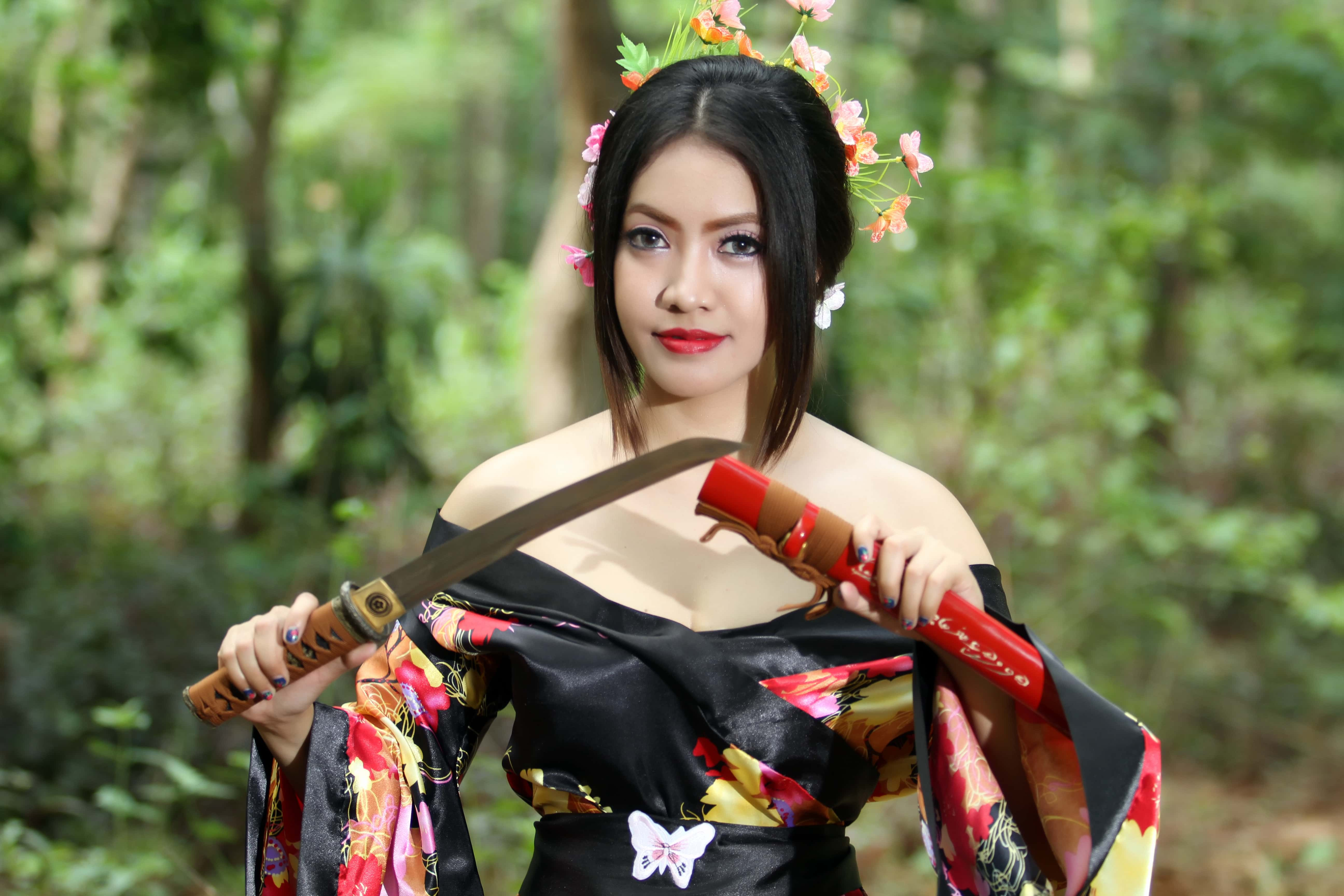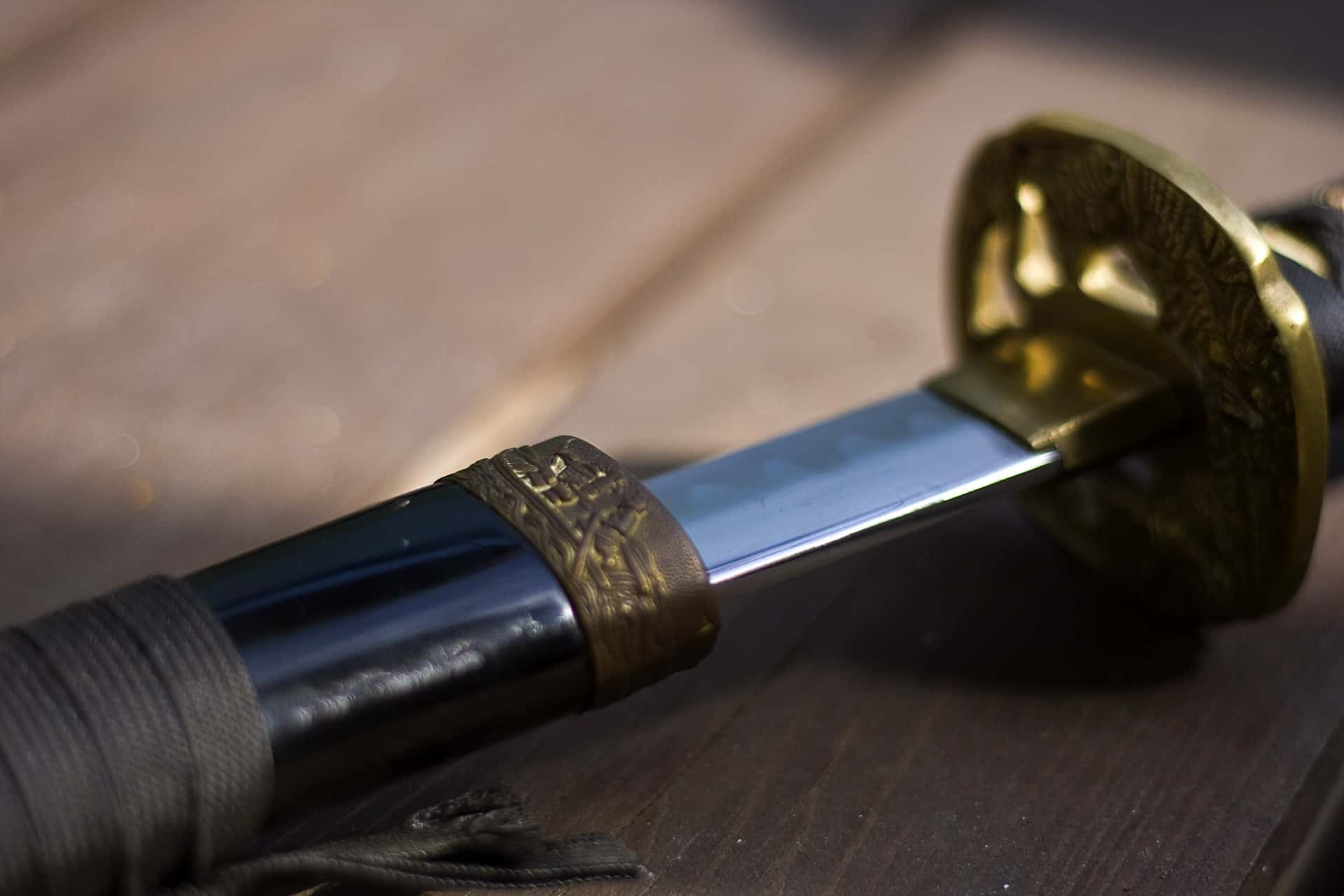For several centuries, there was a branch of warriors among the Japanese nobility that was made up entirely of women. These were the onna-bugeisha, and Japanese history features several of them as renowned warriors more than the equal to their male counterparts. Their ranks included some of the most deadly and cunning women of all time. Read on to learn more about this mysterious order of femme fatales.
1. “Women Who Aren't To Be Messed With” Was Already Taken
Translated into English, the term “onna-bugeisha” basically means “female martial artist". However, these women weren’t limited to bare-handed fighting. Not only were they skilled in martial arts, but they also fought equally well with weapons.

2. Equal Opportunity Combat
An onna-bugeisha's purpose was to defend one’s home, clan, or honor during a time of great trouble. When the situation was most dire, the onna-bugeisha would fight alongside male samurai. This happened many times across the long years of Japanese history.
3. Room for More Than One Kind of Woman
We do, of course, have to note that despite the presence of the onna-bugeisha, they were still the exception rather than the rule within ancient Japanese culture. Traditionally, Japanese ideas of femininity called for a very submissive sort of woman, which meant that the battle prowess of the onna-bugeisha was a starkly contrasting image.
4. We’ve Been Around for Ages!
Incredibly, the onna-bugeisha predate samurai! Long before the samurai were established within Japanese culture, women were trained in the ways of battle so that even if the men were absent from a village, there would still be a fighting force around to protect it from raiders.
5. Warrior Queen
Recognized as an onna-bugeisha, Empress Jingū was one of the first warrior-women who appears in the ancient texts of Japan. Jingū was allegedly a regent serving in place of her deceased husband and young child. However, she proved herself an efficient ruler in her own right. One of her most famous (and controversial) achievements was her successful conquest of the Korean peninsula.
6. Wait, What?!
When we say “controversial” to describe Empress Jingū’s conquest of the Korean peninsula, we don’t just mean because of Japan’s prickly relationship with Korea over the years. We mean it’s controversial because many people dispute that Jingū’s conquest, or even Jingū herself, even existed! The conquest is never mentioned in Korean history, and various alleged facts about Jingū point to her being more of a legend than a historical figure.
7. She’s Marked in the History Books
Whether she was real or not, Empress Jingū is nevertheless impossible to ignore in the history of the onna-bugeisha, or the history of Japan. In 1881, Japan released a banknote which contained an image of her (though it was reportedly based on a female employee of Japan’s Printing Board since no images of Jingū exist). Whether you believe she existed or not, Empress Jingū was the first woman to be featured on a Japanese banknote.
8. Archery
Throughout the history of the onna-bugeisha, there was an emphasis on defending one’s home from invaders. As a result, the primary emphasis on arms training was with ranged weapons that were launched from a defensive structure. This often meant that the onna-bugeisha wielded bows and arrows.
9. Got You in My Sights!
Besides archery and other ranged techniques, the onna-bugeisha were well known for their use of the naginata. This weapon consists of a long blade atop a pole. This cross between a sword and a spear serves well not only against cavalry, but also in keeping larger foes at bay from a distance.
10. Knowledge is Power
Aside from combat, the onna-bugeisha were also often highly educated in other matters. Whether the subject was literature, mathematics, or science, the onna-bugeisha were certainly jills of all trades, so to speak.
11. All in the Textbook
The use of the naginata by the onna-bugeisha became a very famous symbol within Japanese culture. It was known as the signature weapon of warrior women, to the point where schools teaching the use of the naginata were set up around this idea. During the 17th, 18th, and 19th centuries, these educational institutions pushed the idea that the naginata was a woman’s weapon, and not in a derogatory manner.
12. We Remember
While the onna-bugeisha lifestyle has since faded into history, the figures who arose during its existence have never been forgotten. Women like Niijima Yae, Tomoe Gozen, and Hangaku Gozen have all been portrayed countless times in Japanese art and pop culture.
 Wikimedia Commons, Toyohara Chikanobu
Wikimedia Commons, Toyohara Chikanobu
13. Time to Step Up!
In the late 15th century, Japan was torn apart by the Onin War. Over the course of 10 years, this civil conflict embroiled nearly the entire archipelago. During this time, with all the casualties among the male population, the onna-bugeisha became all the more valued. Women from all the different classes stepped forward to either guard their societies or go to battle on either side of the conflict.
14. The Family That Fights Together
At the start of the 13th century, the Kamakura Shogunate was confronted with the Kennin Uprising. At the fort of Tossakayama, a fierce battle was being waged between armies representing both sides of this conflict. One of these armies was led by two people in particular. One was Jo Sukemori, and the other was Sukemori’s aunt, Hangaku Gozen.
15. Not Going Down Without a Fight
Although Hangaku Gozen was renowned as a warrior, she and her nephew were outnumbered more than three to one as they held the fort at Tossakayama. Eventually, despite all efforts, the fort was taken. Hangaku fought valiantly on horseback, but she was eventually wounded and captured by the enemy.
16. Who Doesn’t Love a Strong Woman?
Contrary to what you might think, Hangaku Gozen's enemies deeply admired her for her bravery and battle prowess. Even when she was taken prisoner and her cause defeated, some of the very men she’d been fighting hoped to marry her!
17. Let’s All Settle Down…
The 15th and 16th centuries saw a marked change in how Japanese society functioned, and with these changes went the previously established view of the onna-bugeisha. Where the samurai went from being warriors to bureaucrats and politicians, the onna-bugeisha became more subservient in their revised social status.
18. Dagger Fight
Aside from archery or the naginata, onna-bugeisha were trained in the art known as Tantojutsu. This was a style of fighting which made use of a dagger called a tanto, later referred to as a kaiken. This fighting style was used for self-defense, and a version of it could also be learned for battle.
19. Try it Yourself!
If you’re curious about how Tantojutsu works, and how these warrior women used it to fight, you might be pleased to know that Tantojutsu is still very much a practiced art. It is common in Japan to this day and depending on where you live, you might very well be able to enroll in classes to learn it. We take no responsibility for what happens after you learn it, though!
 Flickr, Akban Martial arts academy
Flickr, Akban Martial arts academy
20. Let’s Bring Them Back!
During the 17th century, there was what you might call a bit of a renaissance regarding samurai and onna-bugeisha. With the establishment of the Tokugawa Shogunate, there was a renewed interest in training women how to fight and defend themselves, their homes, and their villages.
21. We Don’t Need No Man!
During the rule of the Tokugawa Shogunate, an elite unit of female warriors was formed and trained extensively to be as ruthless in battle as possible. Known as the Joshitai (women’s army), they were kept separate from the command of men, being led by women.
22. You Call Me Commander!
In the late 1860s, while the United States was recovering from their civil conflict, the Japanese had a civil conflict of their own. The Boshin War was fought between the forces of the Imperial Court and the forces of the Tokugawa Shogunate, which was fading from power. Amongst the prominent figures fighting for the shogunate was Nakano Takeko, who was leading the Joshitai at the time.
23. Child Prodigy
Nakano Takeko had shown an incredible promise throughout her life. She had been trained in martial arts and military intelligence since she was a child. Takeko was known for her physical skills, but also for her excellent memory. According to the histories, Takeko started memorizing works of classic Japanese literature when she was just five years old!
24. Stateswoman
It wasn’t just the battlefields that provided a place for the onna-bugeisha to make a difference. Hōjō Masako was one of the most prominent of this warrior class to go into politics. During the late 12th and early 13th centuries, Masako wielded incredible political power, which she used to further her own family’s fortunes.
25. To the Bitter End
Ueno Tsuruhime deserves a mention on this list. While she wasn’t exactly listed as being one of the onna-bugeisha, she was nonetheless hailed as a warrior-woman in the annals of Japanese history. In 1575, Tsuruhime and her husband defended Bicchu Matsuyama Castle from an army of invaders. As the siege wore on, and things looked hopeless, Tsuruhime became determined to die fighting.
26. He was Probably Scared He’d Lose
In a move that would make her famous, Ueno Tsuruhime prepared to charge out of the gates of her castle and die as a warrior. With an impassioned speech, she inspired 33 other women to do the same. The women charged into the astonished ranks of her enemies and fought their way over to the main enemy camp, where Ueno challenged the leader of the army to a duel. Said leader refused to fight Tsuruhime because of her gender, but acknowledged her honor.
While she and the women who accompanied her on the charge would ultimately take their own lives, Tsuruhime’s legacy endured long after her passing.
27. Duly Noted
One of the most crucial and fascinating documents ever discovered related to Japanese history is the Azuma Kagami. This historical chronicle from the 13th century serves to depict the events of the Kamakura Shogunate’s timespan. It is through this document that we know of the story of Hangaku Gozen.
28. Bringing a Firearm to the Fight
Speaking of the Battle of Aizu in 1868, another famous warrior woman who was present there was the figure known as either Yamamoto Yae or Niijima Yae. Yae’s father was not only a samurai but also a gunnery instructor. Since Japan had embraced firearms by this time in their history, Yae was one of the first warrior women to become known for her use of guns in combat. In her case, she fought at the Battle of Aizu with a Spencer carbine.
29. Two Badasses on the Run
After the defeat of the forces loyal to the shogunate at the Battle of Aizu, Niijima Yae retreated and went into hiding for a time. Interestingly, one of her companions was none other than Nakano Yuko, the sister of Nakano Takeko, and who had buried her sister’s head in secrecy (as if you’d forget an anecdote like that).
30. With Her Boots Off
Despite the end of the samurai ways, Niijima Yae would not die with those times. Instead, she evolved to embrace the new way of things. Rather than continuing to fight as a gunwoman, Yae turned to nursing. She was a member of the Japanese Red Cross and worked in that vocation during the First Sino-Japanese War and the Russo-Japanese War. She passed on peacefully in 1932.
31. She is Counted
Speaking of tributes to the onna-bugeisha, Nakano Takeko is particularly honored even to this day. A monument stands by the Hokai Temple, where her severed head was buried. Moreover, it is a tradition for young women participating in the Aizu Autumn Festival to wear traditional clothing called hakama, as well as shiro headbands, in honor of Takeko’s heroism.
32. Femme Fatale Indeed
One of the most well-known onna-bugeisha was Tomoe Gozen. While she lived in the 12th and 13th centuries, stories were already being written about her in the 14th century. Gozen was reported to have been very skilled at both archery and swordplay, as well as being such an accomplished equestrian that she frequently rode untamed and unbroken horses.
33. Who Said I Didn’t Exist?!
Sadly, like with Empress Jingū, it's worth pointing out that there is some dispute over whether Tomoe Gozen ever really existed. Despite any doubts about her existence, however, there can be no doubt of her impact upon subsequent Japanese history. She was portrayed many times in art and was often used as an inspiring figure in schools which trained the use of the naginata.
34. Don’t Make it Weird
Such was Tomoe Gozen’s reputation that whenever battle was imminent, she was often the first captain sent into the fray, and according to The Tale of the Heike, she would always be armed with a massive sword. We can’t imagine that would have caused any inferiority complexes for any of the male samurai fighting alongside her!
35. Don’t Cross Me
Tomoe Gozen was married to Minamoto no Yoshinaka, with whom she’d ride into combat at the Battle of Awazu on February 21, 1184. Despite being heavily outnumbered, the forces of this power couple fought bravely against all odds. Gozen, in particular, became famous for her conduct, slaying and beheading several famous warriors in the fray.
36. Seriously?!
Sadly, we can’t tell you that Tomoe Gozen and her husband, Minamoto no Yoshinaka, won the Battle of Awazu together, nor even that they perished side by side fighting the good fight. The battle did lead to a rout, and soon enough, Yoshinaka and Gozen were left with only a few of their followers still standing. Yoshinaka told Gozen to flee the battle, but not for any noble reason that you’d assume would come to mind—he didn’t want to die fighting alongside a woman, even if it was a woman as brilliant as she was.
To be honest, we can’t imagine Gozen needed much persuasion to leave Yoshinaka after that kind of reasoning.
37. Those Who Did, Now Teach
It's unknown what exactly happened to Tomoe Gozen after her leaving the Battle of Awazu. Historians aren’t sure whether she really did leave the battlefield when she was told to leave, or whether she ignored Minamoto no Yoshinaka and stayed to die in battle. Various versions of her story have her either becoming a nun or marrying another samurai.
38. This Theory Has Our Vote!
According to The Tale of the Heike, Gozen founded a school which was specifically meant to teach fighting skills to women. So we can safely say that she made a lot of positive contributions to history!
39. Nakano’s Last Stand
The 1868 Battle of Aizu would serve as both Nakano Takeko’s shining moment of glory and also her demise. Takeko famously led a charge at the forces of Imperial Japan. Unfortunately, the charge resulted in her being shot in the chest. She would die on the battlefield, along with many others fighting for the shogunate.
40. Was it Buried in a Box? Does Brad Pitt Know What was in it?
Even as she faced the end, Nakano Takeko had an important final request. Allegedly, she begged her sister, Yuko, to prevent the enemy from taking her head as a trophy from the battlefield. Takeko’s instructions for doing so were a bit less than conventional: she wanted her sister to cut off her head and bury it in secrecy.
While most relatives might have a few issues with fulfilling those last wishes, Yuko agreed to do it. After beheading her sister, Yuko took Takeko’s severed head and fled the victorious forces of the Imperial Court. Takeko’s head was buried under a pine tree by the Hokai Temple.
41. How Many?!
At the time of her demise, Nakano Takeko reportedly had a kill count of 172 samurai! We can assume that even Gimli or Legolas would blink at that number.
42. The Times a’Changed
With the demise of Nakano Takeko at the Battle of Aizu, this arguably marked the end of the onna-bugeisha within Japanese society in general. Everything went downhill for them after that as their numbers declined and society changed irrevocably as the 19th century gave way to the 20th.














































